Types of Appliances
To successfully complete your orthodontic treatment plan, patients must work together with the orthodontist. The teeth and jaws can only move toward their corrected positions if the patient consistently wears the elastics (rubber bands), headgear or other appliances as prescribed.
The following paragraphs describe the types of appliances that may be used during your treatment.
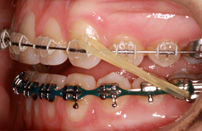 Elastics (Rubber Bands)
Elastics (Rubber Bands)
Wearing elastics (rubber bands) is the main way that Orthodontic treatment can improve the fit of your bite. Braces will straighten your teeth, but are unable to correct bite problems unless used in conjunction with elastics.
TEETH HAVE NEVER FAILED TO MOVE IF ELASTICS ARE WORN AS PRESCRIBED!
You will have some discomfort for the first few days, but as long as you continue to wear your elastics as directed, the discomfort will go away. Ibuprofen can help you through the first few days, if you are finding it uncomfortable. Poor elastic wear is the #1 cause of patients wearing their braces longer than predicted. Orthodontics is a partnership between the patient and the doctor, so you must do your part to help complete your treatment successfully and on schedule.
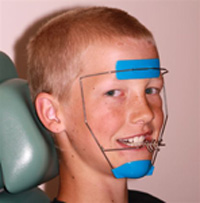 Reverse Headgear
Reverse Headgear
Headgear is used to treat patients whose teeth are in an "under-bite," (with the lowers forward of the uppers). Headgear gently "pulls" on your upper teeth/jaw to bring it forward. Reverse headgear can be used in conjunction with other appliances such as an expander or braces.
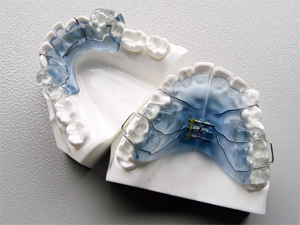 Twin Block Appliance
Twin Block Appliance
The Twin Block appliance reduces the overbite by encouraging forward growth of the lower jaw. It uses 2 removable block-type appliances that fit together like a puzzle. It must be worn full-time to retrain the jaw muscles to hold the lower jaw in the new, more forward position, and to achieve the desired jaw change. This appliance is used mostly for younger, growing children and is worn for about 6-9 months.<
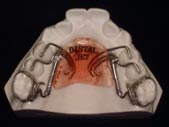 Distal Jet Appliance
Distal Jet Appliance
A distal jet is an appliance that slowly and gently moves the upper 6-year molars further back in the mouth. This will create space for eruption and possibly reduce the amount of crowding for the permanent teeth.
The distal jet has 3 main pieces: the acrylic (pink plastic) part that fits onto the roof of the mouth; the metal parts that rest on and around the teeth; and the spring mechanism which connects from the acrylic to the metal bands around the 6-year molars. These springs move the molars back and will be activated by Dr. Bibby at each adjustment appointment. The degree of activation depends on how much movement is necessary to achieve the ideal end result. There is also a small screw that can be turned with a key in order to expand/widen the upper jaw. Some people do not require this and Dr. Bibby will instruct you as needed.
The distal jet will affect speech and swallowing for a short period following insertion, but it is very important to continue speaking and swallowing normally to allow your lips and tongue to get used to the appliance quickly. Warm salt water rinses are great for helping to alleviate any discomfort or sore spots in the mouth.
It is very important to keep the teeth, gums, and appliance as clean as possible to avoid plaque build-up and irritation or swelling of the gum tissue. A space may open up between the back teeth as the molars move backward- DO NOT BE ALARMED - it is a good sign and means progress is being made. Please contact the office if the appliance ever feels loose or if there is ongoing pain.
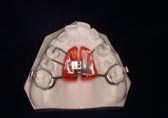 Rapid Palatal Expander (RPE)
Rapid Palatal Expander (RPE)
The palatal expander "expands" (widens) your upper jaw by putting gentle pressure on your upper molars each time an adjustment or turn is made. As the two sides of the upper jaw are moved apart, a space may develop between your upper front teeth, which is normal. Dr. Bibby and staff will instruct you on how to turn your expander, and how often. After you achieve the desired expansion, the appliance will still be worn for several months to solidify the expansion and to prevent regression.
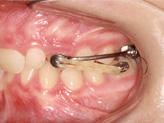 Class 2 Carriere Appliance
Class 2 Carriere Appliance
The Class 2 Carriere Distalizer is an orthodontic device developed to correct a bite without removing permanent teeth when teeth have erupted incorrectly. With an effect similar to headgear, but without the use of a bulky appliance, the Class 2 Carriere Distalizer pushes upper teeth back to create a corrected bite prior to the addition of braces.
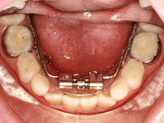 Williams Appliance
Williams Appliance
The Williams expander is a fixed appliance used to develop and widen the lower arch while primary teeth are still in place. As the appliance widens, it allows some improvement of lower crowding. It is followed by a fixed holding appliance (space maintainer) until most or all of the baby teeth are lost.
Using a Williams expander at the most appropriate time will allow the braces correction (Phase II) to be more stable and less complex. It also decreases the likelihood that permanent tooth extractions will be indicated.
 Retainers
Retainers
Retainers may be removable or fixed. They hold your teeth in their new, correct positions after your teeth have been straightened. We will instruct you on how to care for your retainer and the duration of wear. Wearing your retainer as directed is crucial to maintain correct alignment.
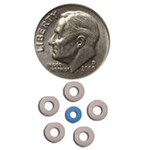 Separators (or Spacers)
Separators (or Spacers)
Separators are little rubber doughnuts that may be placed between your teeth to push them apart so that orthodontic bands may be placed during your next appointment. The separators will be removed before we place the bands. Separators do not mix well with sticky foods or with toothpicks and floss.
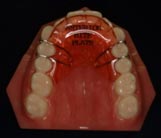 Bite Plate
Bite Plate
A bite plate is a small, acrylic appliance with metal clasps that clip onto the inside of the top teeth. In general, the bite plate is used at the beginning of treatment to help correct a "deep bite" (when the upper teeth overlap the lower teeth too much). Wearing a bite plate can be very strange and uncomfortable at first.
The appliance prevents the back teeth from touching, so you will need to use your front teeth for chewing. Speaking and swallowing will also improve in a few days. Your bite plate WILL be difficult at first, but works quickly and effectively if it is worn as directed by Dr. Bibby.
The bite plate is to be worn 24 hours per day and removed ONLY for cleaning. Most of the correction occurs during chewing making it essential to wear it during eating. It will prevent breakage of the lower braces if worn as directed. If you are having ANY problems, please call our office right away so we can adjust it. If left out even for a short period of time, the teeth can shift enough that the bite plate no longer fits. This will extend your treatment time and necessitate a fee to replace the bite plate.
Holding Arches or Space Maintainers
Holding arches, or "space maintainers", are small fixed appliances that are anchored on the molars with a bar that extends from one side of the arch to the other along the inside. Sometimes they are used when a primary tooth has fallen out or has been extracted early (to make room for permanent teeth), or if an expansion device has been used.
Flossing around the molars and in between the teeth is still very important and recommended daily, as well as following a consistent brushing routine of at least two times per day. Patients should avoid sticky foods such as gum, toffee, caramel and gummy bears as these can loosen or bend the holding arch. Please also avoid hard foods such as whole nuts and chewing on ice.
A holding arch will usually stay in a person's mouth until all or most of the permanent teeth are present; which for most people is around age 12-13 years.
Please advise us immediately if your holding arch becomes loose, bent, or is causing discomfort.
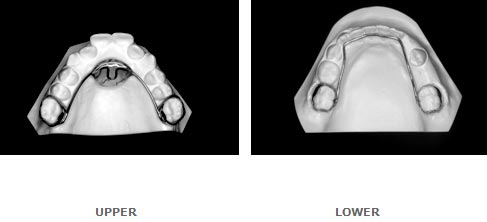

 Website Powered by Sesame 24-7™
Website Powered by Sesame 24-7™